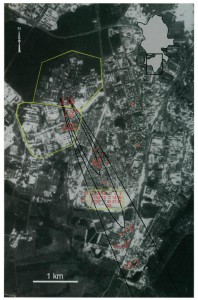Public health response depends on epidemiological factors such as how long the agent stays virulent and on dispersion methods. However, biological agents can be dispersed from a single point but spread through a separate exposure pathway, such as a river or public transportation, and then create more contagious point-sources for the disease (See chart below). An epidemiological approach to the dissemination of a biological agent across a population can help outline geographically the political economic and public health concerns associated with a biological weapon attack.
|
Point Source |
Line Source | Area Source |
| Catapulting a plague-infected, flea-infested body into a city. | Aerosol dispersal of anthrax by plane or wind. | Explosion of bomblet sends biological agent across an area and into the air. |
| Assassination techniques, such as botulinum toxin-laced milk (South Africa). | Cholera infestation follows river lines in down-river water supplies. | Cholera-infected feces in water supply (can manifest as a point-source public health crisis) |
| Communal contact with deceased patients at funerals and graveyards. | Transit routes disperse smallpox-infected patients in patterns. Patients then transmit the virus as point-sources through exhalation or contact. | Entire neighborhoods around a bioweapon production facility fell ill with anthrax in Sverdlovsk in 1979. |
Case Study: Sverdlovsk Anthrax Outbreak

With 61 deaths and 11 non-fatal cases in the span of 6 weeks, Sverdlovsk’s anthrax outbreak was quite high profile. However, it took decades for epidemiologists to be able to visit Russia’s fourth largest city (now Yekaterinburg) and piece together the case. Fearing that the anthrax outbreak might expose Soviet era biological weapons testing banned under the Biological Weapons Convention (1972), KGB confiscated all patient health records, requiring in-person interviews to retrospectively study the outbreak.
This map displays the findings of Meselson et al (1994), in which epidemiologists charted all patients (represented by red numerals) whose work, residence, or whereabouts in the days prior to their illness lined up with the given zone. This zone was the projected distance that aerosolized bacillus anthracis could travel if it came from Sverdlovsk’s local military facility. Areas in boxed in yellow were high risk zones where many of the 55 male, (on average) middle-aged patients worked.
This suggests that despite the fact that biological weapons have the potential to broadly infect members of a population in a given area, certain demographics and spaces are more vulnerable than others. In this case, men working at the Sverdlovsk military compounds (upper left) and at a ceramics factory (bottom center) were in high risk zones. Since anthrax is not contagious beyond initial contact, these demographics suffered disproportionately from their proximity to hazardous biological agent production. Furthermore, in the days following the first case of human anthrax on April 4, 1979, specific livestock from villages up to 50 km outside of Sverdlovsk were slaughtered after examinations confirmed cases of animal anthrax in cattle and sheep. Meselson et al (1994) conclude that these anthrax cases resulted from the emission and travel of anthrax spores by wind from a military microbiology facility at the local military compound.
Takeaways
The epidemiology of the Sverdlovsk outbreak reveal important realities of a biological agent incident:
- While some incidents are easy to identify as the work of a weaponized agent, political incentives to maintain political support, national image, and national security can overpower transparency in public health response. This perspective on critical epidemiology may be useful to those studying health effects of chemical, biological, radiological, or nuclear weapons or even environmental contamination from state-owned industries.
- If information and/or access is withheld, it can take decades to uncover the true causes of a public health outbreak. This was especially difficult for Meselson et al because animal anthrax was an endemic zoonosis in the region at the time and presented as a logical alibi for Soviet officials.
- Place matters. Where a biological agent falls will disproportionately affect the health of specific demographics that cluster in that space. Similarly, in an attack, perpetrators may choose the site of the attack based on political vulnerability or what social repercussions will ensue from threatening that space. Biological agents leave marks not only on health landscapes but also on cultural landscapes, giving certain places (such as Sverdlovsk’s microbiology facility) permanent political meaning.